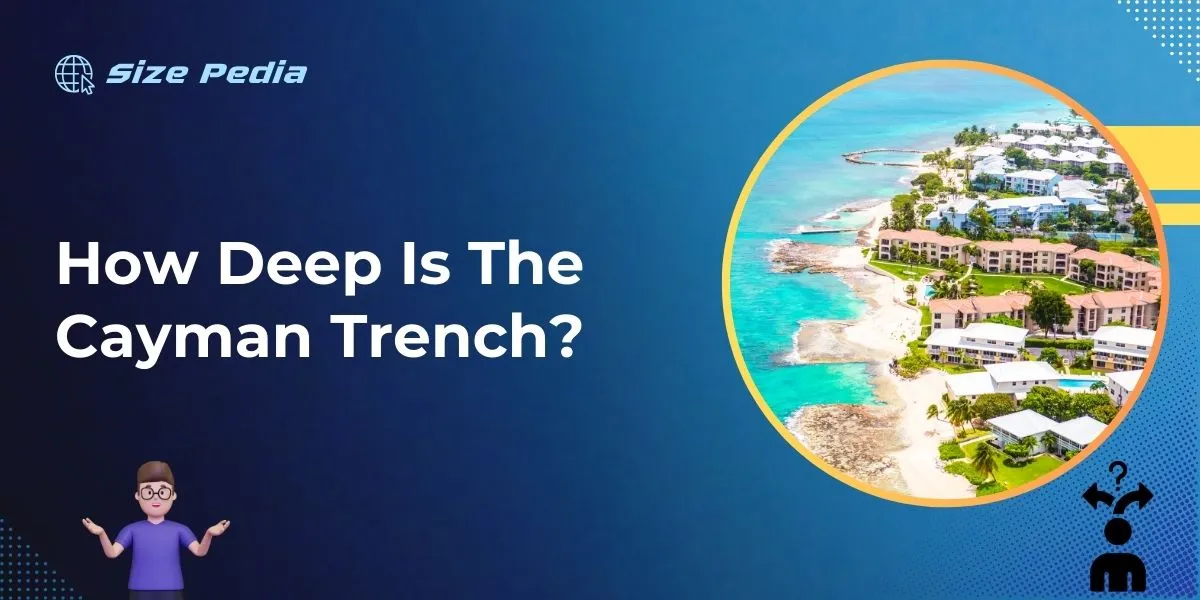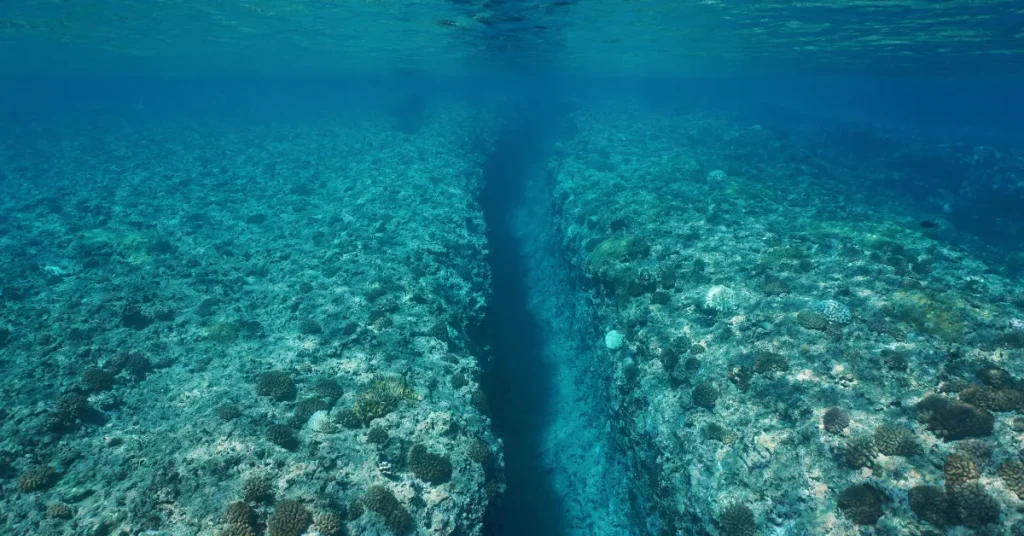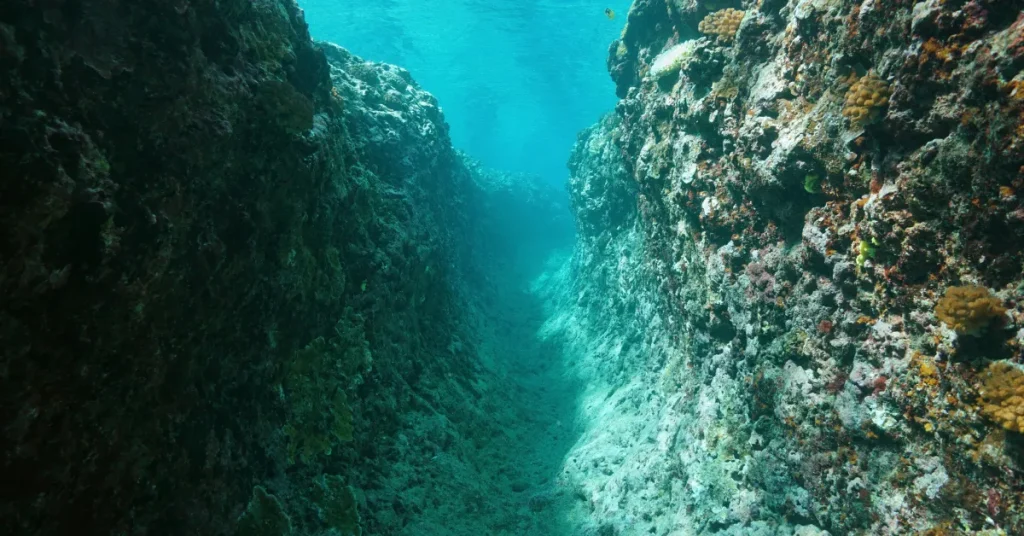The Cayman Trench, the deepest part of the Caribbean Sea, reaches depths of over 7,500 meters (25,000 feet). It is one of the deepest oceanic trenches in the world.
Beneath the sapphire waters of the Caribbean, the Cayman Trench plummets into an abyssal plain, creating an underwater environment of mystique and scientific curiosity.
Spanning over 1,100 kilometers between Jamaica and the Cayman Islands, this trench plays a vital role in local tectonic activity and marine biodiversity.
It serves as a unique haven for deep-sea creatures and remains a point of interest for geologists and oceanographers worldwide.
The trench’s geological features, including its steep walls and complex formations, continue to allure those passionate about the secrets of the ocean’s depths.

Plunging Into The Depths: The Cayman Trench
The Cayman Trench is an underwater marvel, beckoning with its mysterious depths. It’s a place of profound wonder, hidden beneath the waves of the Caribbean Sea.
Picture an immense chasm, plunging into the abyss, and you’re only beginning to understand the enigma of the Cayman Trench.
Geographical Location Of The Cayman Trench
A colossal rift between the Caribbean Sea and the Western Atlantic Ocean, the Cayman Trench boasts an impressive locale.
- North of Jamaica, a stone’s throw away in oceanic terms.
- East of the Cayman Islands, marking its namesake.
- Stretching alongside Cuba’s southeast coast.
Comparative Depth With Other Oceanic Trenches
When it comes to depth, the Cayman Trench is in a league of its own. Consider this comparative analysis:
| Trench | Depth (meters) |
| Cayman Trench | 7,686 |
| Mariana Trench | 10,984 |
| Tonga Trench | 10,882 |
| Java Trench | 7,725 |
With a maximum known depth of 7,686 meters, the Cayman Trench is not the deepest, but it is deeper than the Java Trench and rivals many other well-known oceanic canyons.
Formation And Evolution Of The Cayman Trough
Exploring the depths of the Earth often leads us to mysterious places like the Cayman Trough. Situated in the Caribbean Sea, this spectacular feature holds many secrets beneath its waves.
The formation and evolution of the Cayman Trench offer a fascinating glimpse into the forces that shape our planet. Let’s dive into its history and the geological processes that brought it into existence.
Geological Processes Behind Its Creation
The Cayman Trough, which is also known as the Cayman Trench, formed due to complex geological activities.
Two major tectonic plates—the North American Plate and the Caribbean Plate—move apart in a process known as plate tectonics. This movement creates what is known as a ‘pull-apart basin’.
- Spreading Ridges: These are underwater mountain ranges where new crust is generated.
- Transform Faults: These faults accommodate the horizontal movement between plates.
- Subduction Zones: Areas where one plate dives beneath another, though this is less prominent in the Cayman Trough’s formation.
Historical Timeline Of The Trench’s Formation
The Cayman Trough didn’t form overnight but rather through millions of years of Earth’s crustal evolution. Here’s an easily digestible timeline to understand its development:
| Time Period | Event |
| Late Jurassic | The Caribbean Plate begins to form. |
| Cretaceous | Formation of Proto-Caribbean Seaways. |
| Paleogene | Development of the Cayman Trough from plate interactions. |
| Neogene to Present | Further spreading and shaping of the trench. |
Today, the Cayman Trench stands as one of the deepest points in the Caribbean Sea and an important site for geological research.
Measuring The Abyss: Depth Exploration Techniques

The Cayman Trench, a captivating undersea marvel, plunges into the depths of the Caribbean Sea. To grasp its true depth, scientists employ a variety of techniques. These methods have evolved with technology.
They allow a better understanding of this mysterious underwater canyon. Here, we dive into how experts measure the profound depths of such great trenches.
Traditional And Modern Depth Measurement Methods
Explorers have long sought to determine the magnitude of oceanic trenches. The journey from rudimentary rope-and-lead techniques to sophisticated sonar technology is riveting.
Let’s explore both traditional and modern methods that reveal the depth of the Cayman Trench.
- Echo Sounding: Uses sound waves that bounce off the seafloor to measure depth.
- Satellite Altimetry: Employs satellites to gauge the distance to the sea surface, inferring depth.
- ROV and Submersibles: Engage remote or manned vehicles to gather direct data from the trench.
The evolution from weighted lines, known as lead lines, to echo sounders has enhanced accuracy. Modern techniques like satellite altimetry map the seafloor from space.
Meanwhile, submersibles and remotely operated vehicles (ROVs) physically reach the trench’s bottom for the most direct measurement.
Challenges In Deep-sea Exploration
Discovering the true depth of the Cayman Trench is not without its difficulties. The deep sea is an environment packed with challenges that impede exploration. Let’s delve into some of these persistent obstacles.
| Challenge | Impact on Exploration |
| Extreme Pressure | Equipment must withstand immense forces. |
| Darkness | Specialized lighting and sensors are necessary. |
| Remote Location | Access requires significant time and resource investment. |
Extreme pressure and darkness create a hostile environment for machines and humans. The trench’s remote location also presents logistical hurdles. These factors demand robust, innovative solutions for accurate depth measurement. Such conditions push the boundaries of exploration technologies.
Life In The Shadowy Depths
The Cayman Trench, a staggering deep-sea wonder, brims with enigmas. In its shadowy depths, life forms thrive under conditions unfathomable to those on the surface. Let us delve into this dark underwater realm, revealing the resilience of life in extreme environments.
Adaptations Of Organisms To Extreme Pressure
The Cayman Trench plunges over 7,500 meters deep, creating an environment of immense pressure. Organisms living here showcase remarkable adaptations.
- Compressible Bodies: Many creatures possess bodies that can withstand being squeezed.
- Sculpted by Evolution: With streamlined shapes, they endure the pressing force of deep-sea life.
- Chemical Warfare: Unique biochemistry enables them to survive where others cannot.
Discoveries Of Novel Marine Species
Surprising discoveries await in the trench’s murky waters. Scientists continually uncover new species previously unknown to humankind.
| Species | Characteristics | Depth Found |
| Unknown Bioluminescent Fish | Glow-in-the-dark features | 3,000 meters |
| Mysterious Jelly-like Creature | Amorphous body structure | 6,500 meters |
Each new finding provides insights into biological resilience and the vast diversity of marine life.
Human Interactions With The Deep Oceanic Rift
The Cayman Trench isn’t just a marvel of nature, it’s also a hub for human curiosity and scientific exploration. With depths reaching over 7,000 meters, it’s a mystery we’re just starting to understand.
Through daring expeditions and careful studies, we’re uncovering the secrets of this deep oceanic rift.
Submersible Dives And Scientific Research
Submersible vehicles take us where humans can’t usually go – the deepest parts of the ocean.
Inside these high-tech machines, scientists descend into the Cayman Trench. They go down to study life forms never seen before and to chart the unexplored terrain.
- Recording new species: Each dive can reveal creatures adapted to extreme pressure and darkness.
- Geological studies: The trench provides clues about Earth’s tectonic movements and history.
- Environmental impacts: Researchers look at how human activities affect deep-sea life.
Conservation Efforts For Deep-sea Ecosystems
The mysterious life in the Cayman Trench is fragile and unique. Conservationists protect these ecosystems from overfishing and pollution.
| Conservation Activity | Impact |
| Marine Protected Areas | Shields biodiversity hotspots from destruction. |
| Anti-trawling regulations | Prevents damage to the seabed and its inhabitants. |
| Deep-sea mining bans | Stops the loss of unknown and rare species. |
Community education programs spotlight the need to preserve our ocean’s deepest parts. Every action towards conservation helps safeguard the wonders below.
The Trench In Popular Culture And Mythology

Deep under the Caribbean Sea lies the enigmatic Cayman Trench. Its marine mysteries have sparked the imaginations of storytellers and mythmakers across the world.
From inspiring awe to invoking fear, the trench has secured its place in popular culture and mythology. Let’s explore how this submarine spectacle has inspired artists and stirred the superstitions of seafarers.
Inspirations In Literature And Cinema
The Cayman Trench’s unfathomable depths lure adventurers and creatives alike. Writers plunge into its dark waters to craft tales of the unknown. Directors use its abyssal backdrop for harrowing underwater scenes.
The trench is a setting where human curiosity meets its match in the face of nature’s grandeur. Here are key works influenced by the trench:
- ‘20,000 Leagues Under the Sea’ – Jules Verne’s classic novel often associated with deep-sea trenches.
- ‘The Meg’ – A film featuring prehistoric sharks, linking the Mariana Trench with similar deep-sea locales.
- ‘Pirates of the Caribbean’ – This blockbuster franchise alludes to mysterious oceanic trenches filled with mythical creatures.
Myths And Legends Surrounding Deep-sea Trenches
Myths swell from the depths much like the creatures said to dwell within. The Cayman Trench is no exception. It serves as a modern-day Kraken in folklore, spawning stories that grip sailor’s hearts.
Legends teem with tales of monstrous sea beings and sunken cities swallowed whole. Here are a few entwined with the trench’s legacy:
- Sea Monsters – Legends of colossal squids and serpents often find their homes in the darkest recesses of the trench.
- Atlantis – Some yarn-spinners suggest that the lost city could be lurking in the depths of similar undersea canyons.
- Ghost Ships – Stories circulate of spectral ships enveloped by the murky mists above trench waters, forever lost to the abyss.
FAQs About How Deep Is The Cayman Trench
What Is The Depth Of The Cayman Trench?
The Cayman Trench, also known as the Cayman Trough, reaches depths of over 25,000 feet (7,620 meters). It is the deepest point in the Caribbean Sea and a remarkable feature of the ocean floor.
How Does The Cayman Trench Compare To Mariana Trench?
While the Cayman Trench is impressive, the Mariana Trench is far deeper. The Mariana Trench descends to about 36,070 feet (10,994 meters), making it the deepest oceanic trench on Earth.
What Formed The Cayman Trench?
The Cayman Trench was formed by a complex process of geological activity. It is primarily the result of the North American Plate sliding beneath the Caribbean Plate, a process called subduction.
Can You Dive Into The Cayman Trench?
Diving into the Cayman Trench is not possible for recreational divers due to its extreme depth. Only specialized submersible vehicles can reach the deepest parts of this trench.
Conclusion
The Cayman Trench’s depths are truly breathtaking, plunging to over 7,500 meters. This underwater crevasse remains a marvel for scientists and ocean aficionados alike.
Our exploration of its mysterious expanse continues to yield valuable insights into Earth’s geology. Let’s keep diving into the knowledge that lies beneath our ocean’s surface.
Resources:
1. https://www.usgs.gov/publications/nature-crust-under-cayman-trough-gravity
